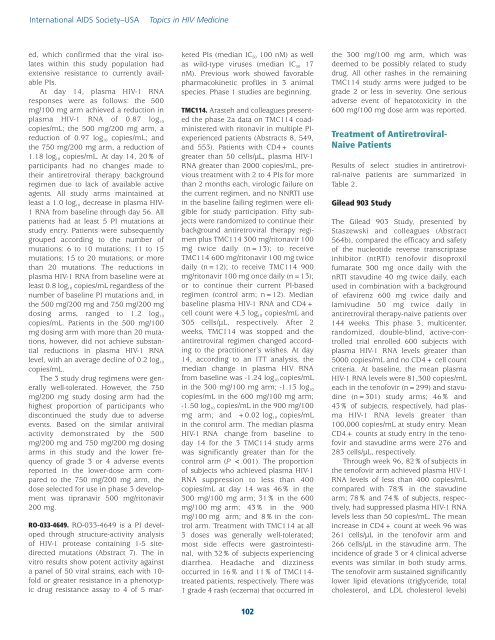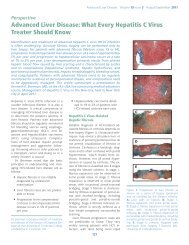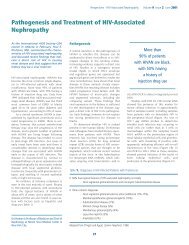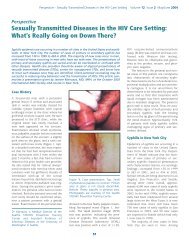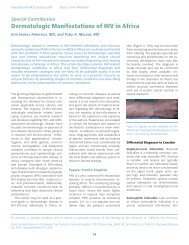Topics in HIV Medicine® - International AIDS Society-USA
Topics in HIV Medicine® - International AIDS Society-USA
Topics in HIV Medicine® - International AIDS Society-USA
You also want an ePaper? Increase the reach of your titles
YUMPU automatically turns print PDFs into web optimized ePapers that Google loves.
<strong>International</strong> <strong>AIDS</strong> <strong>Society</strong>–<strong>USA</strong><br />
<strong>Topics</strong> <strong>in</strong> <strong>HIV</strong> Medic<strong>in</strong>e<br />
ed, which confirmed that the viral isolates<br />
with<strong>in</strong> this study population had<br />
extensive resistance to currently available<br />
PIs.<br />
At day 14, plasma <strong>HIV</strong>-1 RNA<br />
responses were as follows: the 500<br />
mg/100 mg arm achieved a reduction <strong>in</strong><br />
plasma <strong>HIV</strong>-1 RNA of 0.87 log 10<br />
copies/mL; the 500 mg/200 mg arm, a<br />
reduction of 0.97 log 10 copies/mL; and<br />
the 750 mg/200 mg arm, a reduction of<br />
1.18 log 10 copies/mL. At day 14, 20% of<br />
participants had no changes made to<br />
their antiretroviral therapy background<br />
regimen due to lack of available active<br />
agents. All study arms ma<strong>in</strong>ta<strong>in</strong>ed at<br />
least a 1.0 log 10 decrease <strong>in</strong> plasma <strong>HIV</strong>-<br />
1 RNA from basel<strong>in</strong>e through day 56. All<br />
patients had at least 5 PI mutations at<br />
study entry. Patients were subsequently<br />
grouped accord<strong>in</strong>g to the number of<br />
mutations: 6 to 10 mutations; 11 to 15<br />
mutations; 15 to 20 mutations; or more<br />
than 20 mutations. The reductions <strong>in</strong><br />
plasma <strong>HIV</strong>-1 RNA from basel<strong>in</strong>e were at<br />
least 0.8 log 10 copies/mL regardless of the<br />
number of basel<strong>in</strong>e PI mutations and, <strong>in</strong><br />
the 500 mg/200 mg and 750 mg/200 mg<br />
dos<strong>in</strong>g arms, ranged to 1.2 log 10<br />
copies/mL. Patients <strong>in</strong> the 500 mg/100<br />
mg dos<strong>in</strong>g arm with more than 20 mutations,<br />
however, did not achieve substantial<br />
reductions <strong>in</strong> plasma <strong>HIV</strong>-1 RNA<br />
level, with an average decl<strong>in</strong>e of 0.2 log 10<br />
copies/mL.<br />
The 3 study drug regimens were generally<br />
well-tolerated. However, the 750<br />
mg/200 mg study dos<strong>in</strong>g arm had the<br />
highest proportion of participants who<br />
discont<strong>in</strong>ued the study due to adverse<br />
events. Based on the similar antiviral<br />
activity demonstrated by the 500<br />
mg/200 mg and 750 mg/200 mg dos<strong>in</strong>g<br />
arms <strong>in</strong> this study and the lower frequency<br />
of grade 3 or 4 adverse events<br />
reported <strong>in</strong> the lower-dose arm compared<br />
to the 750 mg/200 mg arm, the<br />
dose selected for use <strong>in</strong> phase 3 development<br />
was tipranavir 500 mg/ritonavir<br />
200 mg.<br />
RO-033-4649. RO-033-4649 is a PI developed<br />
through structure-activity analysis<br />
of <strong>HIV</strong>-1 protease conta<strong>in</strong><strong>in</strong>g 1-5 sitedirected<br />
mutations (Abstract 7). The <strong>in</strong><br />
vitro results show potent activity aga<strong>in</strong>st<br />
a panel of 50 viral stra<strong>in</strong>s, each with 10-<br />
fold or greater resistance <strong>in</strong> a phenotypic<br />
drug resistance assay to 4 of 5 marketed<br />
PIs (median IC 50 100 nM) as well<br />
as wild-type viruses (median IC 50 17<br />
nM). Previous work showed favorable<br />
pharmacok<strong>in</strong>etic profiles <strong>in</strong> 3 animal<br />
species. Phase 1 studies are beg<strong>in</strong>n<strong>in</strong>g.<br />
TMC114. Arasteh and colleagues presented<br />
the phase 2a data on TMC114 coadm<strong>in</strong>istered<br />
with ritonavir <strong>in</strong> multiple PIexperienced<br />
patients (Abstracts 8, 549,<br />
and 553). Patients with CD4+ counts<br />
greater than 50 cells/µL, plasma <strong>HIV</strong>-1<br />
RNA greater than 2000 copies/mL, previous<br />
treatment with 2 to 4 PIs for more<br />
than 2 months each, virologic failure on<br />
the current regimen, and no NNRTI use<br />
<strong>in</strong> the basel<strong>in</strong>e fail<strong>in</strong>g regimen were eligible<br />
for study participation. Fifty subjects<br />
were randomized to cont<strong>in</strong>ue their<br />
background antiretroviral therapy regimen<br />
plus TMC114 300 mg/ritonavir 100<br />
mg twice daily (n=13); to receive<br />
TMC114 600 mg/ritonavir 100 mg twice<br />
daily (n=12); to receive TMC114 900<br />
mg/ritonavir 100 mg once daily (n=13);<br />
or to cont<strong>in</strong>ue their current PI-based<br />
regimen (control arm; n=12). Median<br />
basel<strong>in</strong>e plasma <strong>HIV</strong>-1 RNA and CD4+<br />
cell count were 4.3 log 10 copies/mL and<br />
305 cells/µL, respectively. After 2<br />
weeks, TMC114 was stopped and the<br />
antiretroviral regimen changed accord<strong>in</strong>g<br />
to the practitioner’s wishes. At day<br />
14, accord<strong>in</strong>g to an ITT analysis, the<br />
median change <strong>in</strong> plasma <strong>HIV</strong> RNA<br />
from basel<strong>in</strong>e was -1.24 log 10 copies/mL<br />
<strong>in</strong> the 300 mg/100 mg arm; -1.13 log 10<br />
copies/mL <strong>in</strong> the 600 mg/100 mg arm;<br />
-1.50 log 10 copies/mL <strong>in</strong> the 900 mg/100<br />
mg arm; and +0.02 log 10 copies/mL<br />
<strong>in</strong> the control arm. The median plasma<br />
<strong>HIV</strong>-1 RNA change from basel<strong>in</strong>e to<br />
day 14 for the 3 TMC114 study arms<br />
was significantly greater than for the<br />
control arm (P


